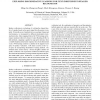121
click to vote
ICASSP
2011
IEEE
14 years 4 months ago
2011
IEEE
Recently, Multiple Background Models (M-BMs) [1, 2] have been shown to be useful in speaker verification, where the M-BMs are formed based on different Vocal Tract Lengths (VTLs)...
98
Voted
ICASSP
2011
IEEE
14 years 4 months ago
2011
IEEE
The majority of speaker verification systems proposed in the NIST speaker recognition evaluation are conditioned on the type of data to be processed: telephone or microphone. In ...
114
Voted
ICASSP
2011
IEEE
14 years 4 months ago
2011
IEEE
Recently, i-vector extraction and Probabilistic Linear Discriminant Analysis (PLDA) have proven to provide state-of-the-art speaker verification performance. In this paper, the s...
83
Voted
ICASSP
2011
IEEE
14 years 4 months ago
2011
IEEE
State-of-the-art speaker verification systems consists of a number of complementary subsystems whose outputs are fused, to arrive at more accurate and reliable verification deci...
99
Voted
ICASSP
2011
IEEE
14 years 4 months ago
2011
IEEE
This paper proposes a feature extraction for speaker characterization by exploring the relationship between the two distinct components of the speech signal, one is harmonics acco...
120
Voted
ICASSP
2010
IEEE
15 years 29 days ago
2010
IEEE
During the last decade, speaker verification systems have shown significant progress and have reached a level of performance and accuracy that support their utilization in pract...
94
Voted
ICBA
2004
Springer
15 years 6 months ago
2004
Springer
We apply the ETSI’s DSR standard to speaker verification over telephone networks and investigate the effect of extracting spectral features from different stages of the ETSI�...
120
Voted
ICMCS
2007
IEEE
15 years 7 months ago
2007
IEEE
Speaker verification is a technology of verifying the claimed identity of a speaker based on the speech signal from the speaker (voice print). To learn the score of similarity be...
109
Voted
ICASSP
2008
IEEE
15 years 7 months ago
2008
IEEE
This paper deals with the interaction between progressive model adaptation and score normalization strategies which are used for reducing the variation in likelihood ratio scores ...
129
click to vote
MM
2009
ACM
15 years 7 months ago
2009
ACM
Speaker clustering is the task of grouping a set of speech utterances into speaker-specific classes. The basic techniques for solving this task are similar to those used for spea...


